Discover the charm of this Italian rice salad, a cold rice salad that promises both flavor and nutrition. This easy recipe merges wholesome ingredients reminiscent of Italy's rich culinary heritage. Whether you're aiming for a full meal on a busy weeknight or seeking a healthy salad for a family gathering, this dish offers a great way to serve up a delectable and satisfying treat.
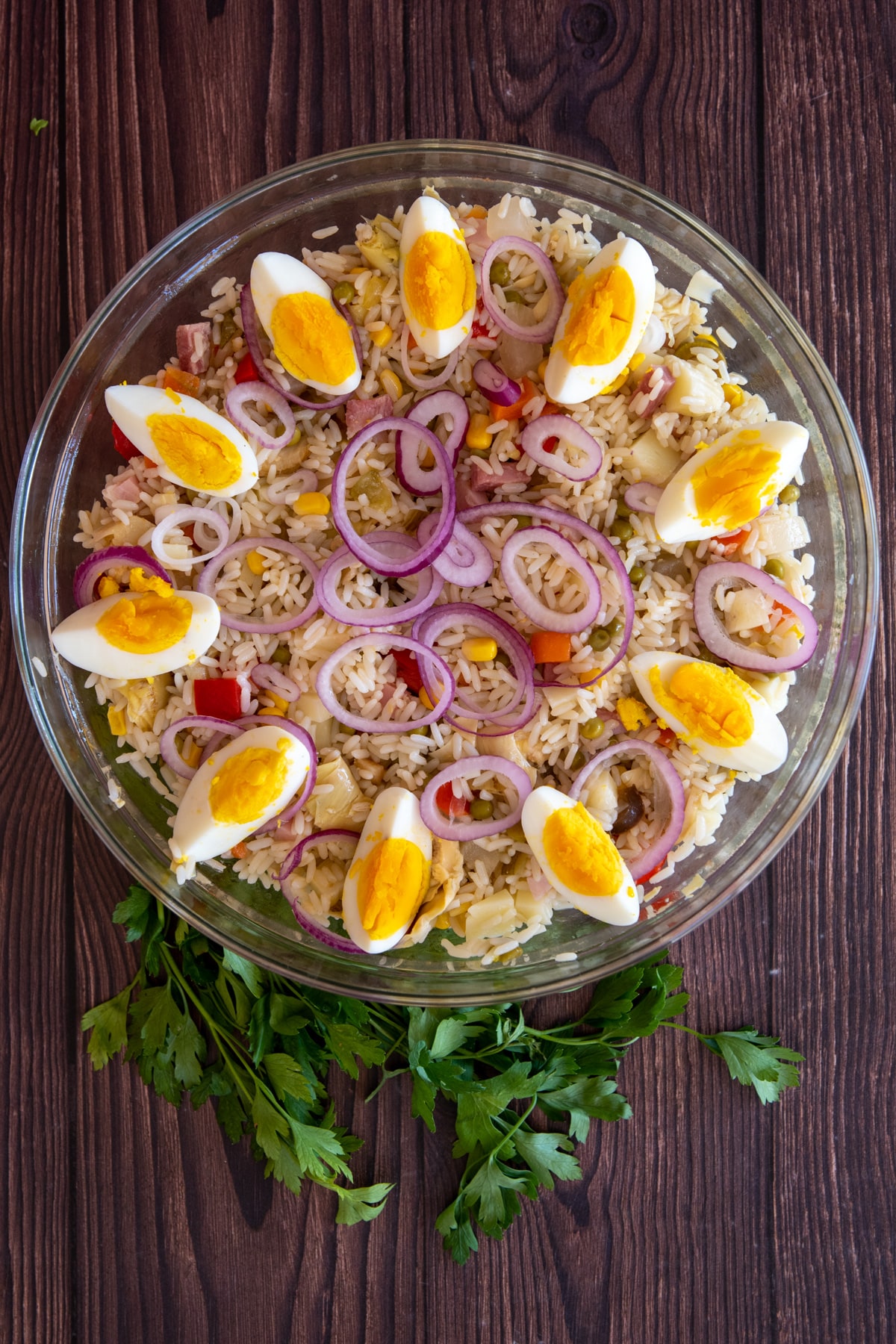
Jump to:
In Italy, rice salad, known as "insalata di riso," holds a special place in the culinary landscape of rice recipes.
Originating from the country's rich rice-growing regions, this dish showcases the Italian penchant for melding simple ingredients into something deliciously complex.
Traditionally, the salad is an amalgamation of cooked and cooled rice mixed with a medley of ingredients like pickled vegetables, tuna, olives, and sometimes even bits of ham or cheese.
Seasonal vegetables, fresh herbs, and a light drizzle of olive oil often complete the mix.
What sets the Italian rice salad apart is its versatility.
Each region and household may have its own version, reflecting local tastes and traditions.
From the addition of seafood in coastal areas to various cheeses in the inland regions, the variations are as diverse as Italy itself.
This easy rice salad recipe, like pasta salad, is especially popular in the warmer months.
It's a staple during summer picnics and outings due to its refreshing nature and ease of preparation.
Moreover, it's frequently found on tables during national holidays and festivals, serving as a cold and hearty option amidst a spread of Italian delicacies.
However, its simplicity and heartiness make it a favorite for many, even as a quick lunch or dinner option throughout the year.
For more Italian rice recipes, you can check: the perfect risotto, rice stuffed tomatoes, baked risotto rice, timballo di riso, arancini.
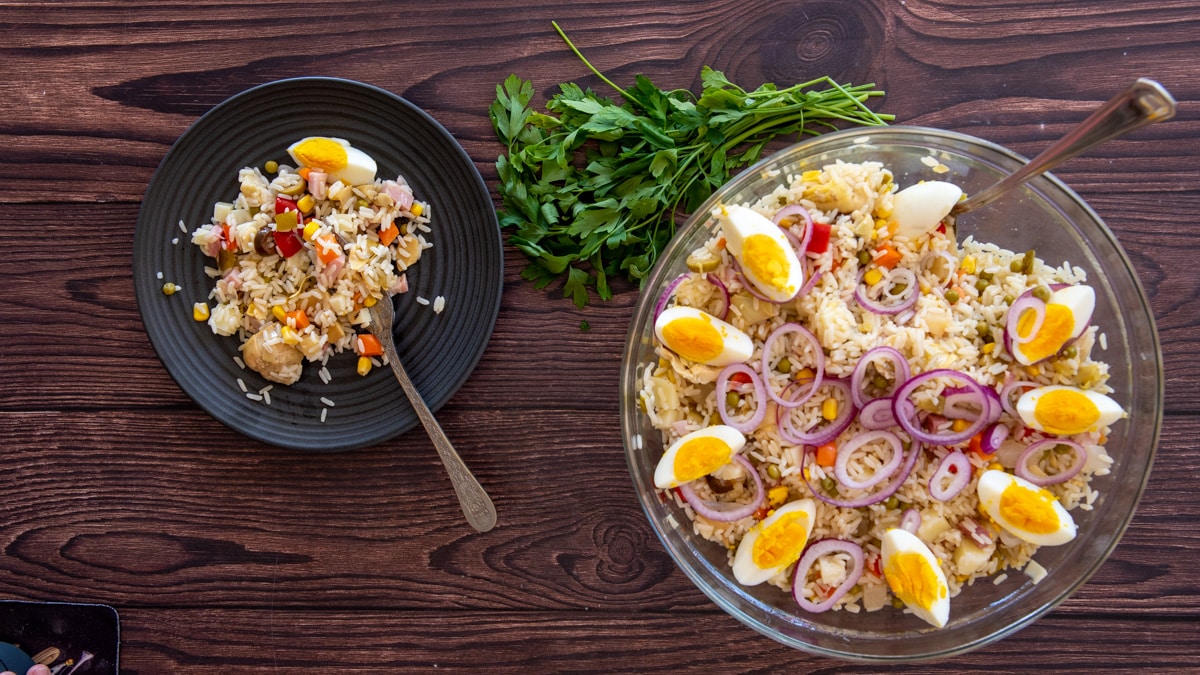
Ingredients
The rice
In crafting the perfect rice salad, the choice of rice is paramount, as it dictates the texture and flavor of the dish.
In Italy, we use Carnaroli, Arborio, Vialone Nano, and Basmati, known for their ability to remain firm and separated, ensuring a delightful bite.
Here are the types of rice you can use:
- Basmati: Both white and brown basmati rice are fragrant long-grain varieties known for their nutty aroma. They're considered some of the best rice types for dishes where individual ricegrains should stand apart.
- Wild Rice: A hearty, chewy option with a unique taste profile, wild rice adds depth to any salad.
- Long-Grain Rice: Varieties like white rice or nutty brown rice ensure that the salad remains fluffy. It is ideal for salads as it prevents sogginess.
- Black Rice: Also called forbidden rice, it has a deep hue and nuttier taste, adding both flavor and visual contrast to the dish.
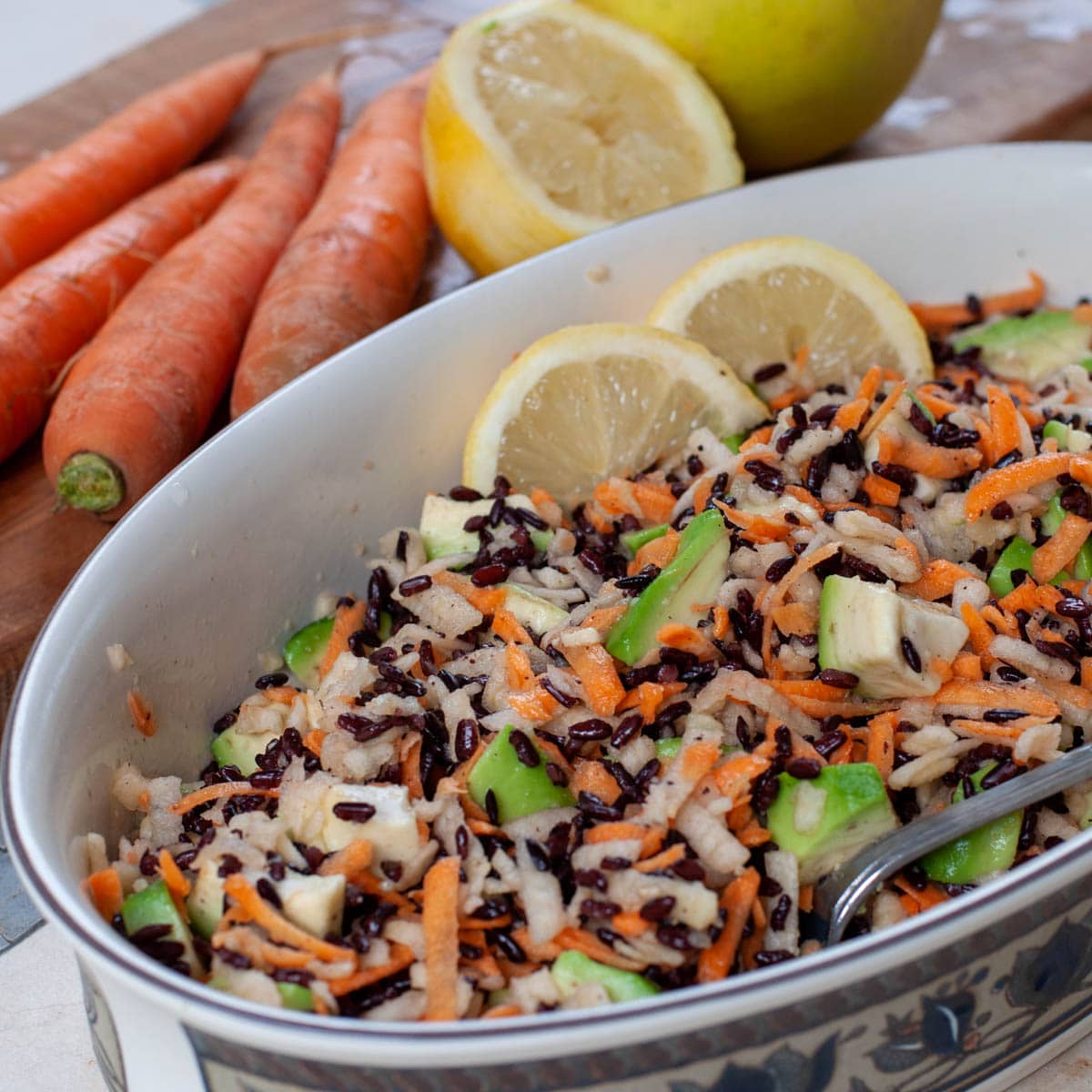
The vegetables
When selecting vegetables for a rice salad, it's essential to consider their texture and flavor profile, ensuring a harmonious blend with the rice and other components.
Choose crisp vegetables that offer a contrasting crunch and select flavors that complement rather than overpower the dish's main ingredients.
- Bell Peppers: Red bell pepper and orange bell pepper provide a sweet crunch, while green onions and red onion offer a sharper bite.
- Cherry Tomatoes: Small and juicy, these tomatoes bring freshness to every bite.
- Sun-dried Tomatoes: They offer a concentrated tomato flavor and a chewy texture.
- Fresh Veggies: The likes of cucumbers, red onions and fresh herbs, like fresh basil, complement the hearty rice.
- Cooked veggies: Like carrots, green beans, broad beans, artichokes, green peas can be used cooked, canned or pickled.
The proteins
When incorporating proteins into a rice salad, prioritize freshness and complementary flavors that enhance, rather than overshadow, the dish's overall profile.
Consider the texture and cooking method, ensuring that the chosen proteins meld seamlessly with the salad's other components.
- Boiled Eggs: They provide a creamy, hearty element to the dish.
- Grilled Chicken: Tender chicken, especially chicken breast, adds lean protein. It complements citrusy flavors, such as orange or lemon juice.
- Cheese: Feta cheese adds tangy creaminess, while cheese cubes give a bite-sized delight.
- Black Beans and Canned Chickpeas: Both add a filling, fibrous element, enriching the salad's texture and nutritional profile.
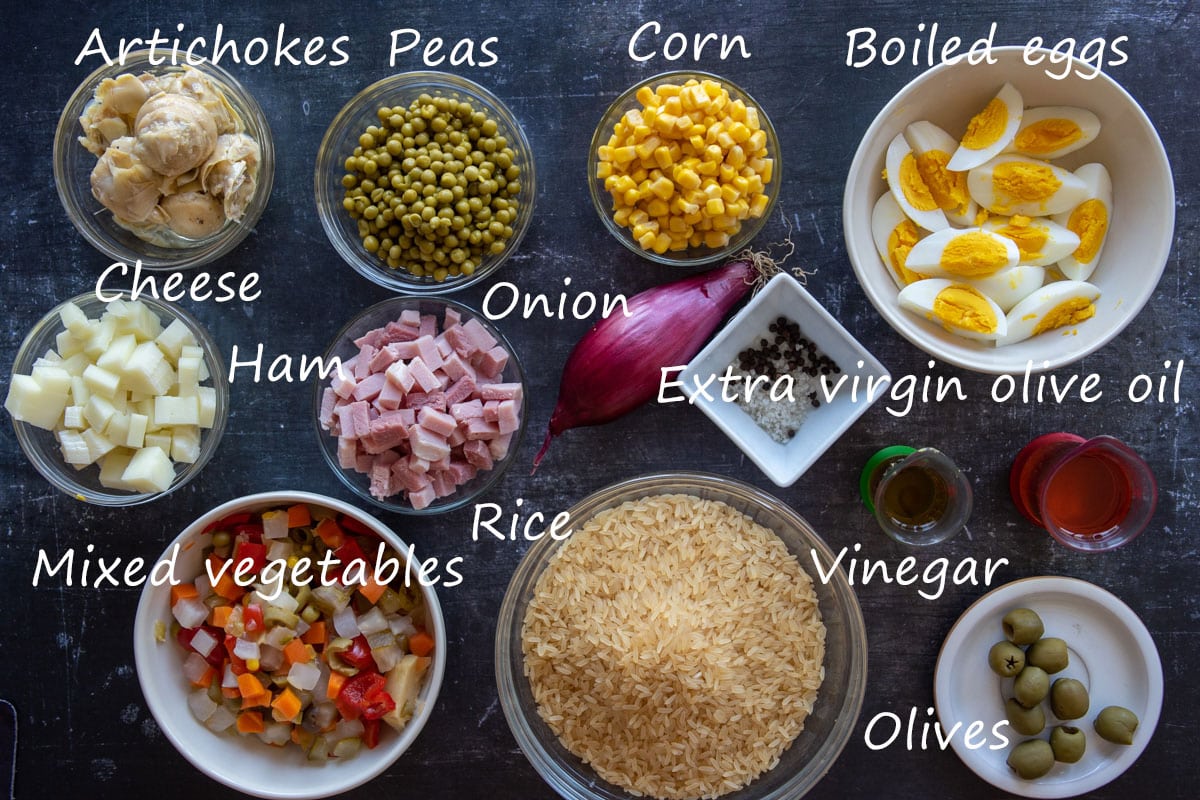
The dressing
Selecting the right dressing for a rice salad hinges on striking a balance between moisture and flavor, ensuring the rice remains distinct while being enhanced.
Consider dressings that complement the dish's ingredients, whether light and zesty or rich and creamy, always aiming for a harmonious melding of flavors without overpowering the primary components.
- Olive Oil: Extra virgin olive oil is a staple, offering a rich base.
- Vinegar: Red wine vinegar and white wine vinegar each offer a different level of tanginess, enhancing the fresh ingredients.
- Lemon Juice and Zest: The zesty freshness of lemon, both its juice and zest, brightens the flavor profile.
- Fresh Oranges: Either juiced or zested, they offer a burst of citrusy brightness.
- Black Pepper and Salt: Essential seasoning to elevate all flavors.
Find more information and measurements in the recipe card.
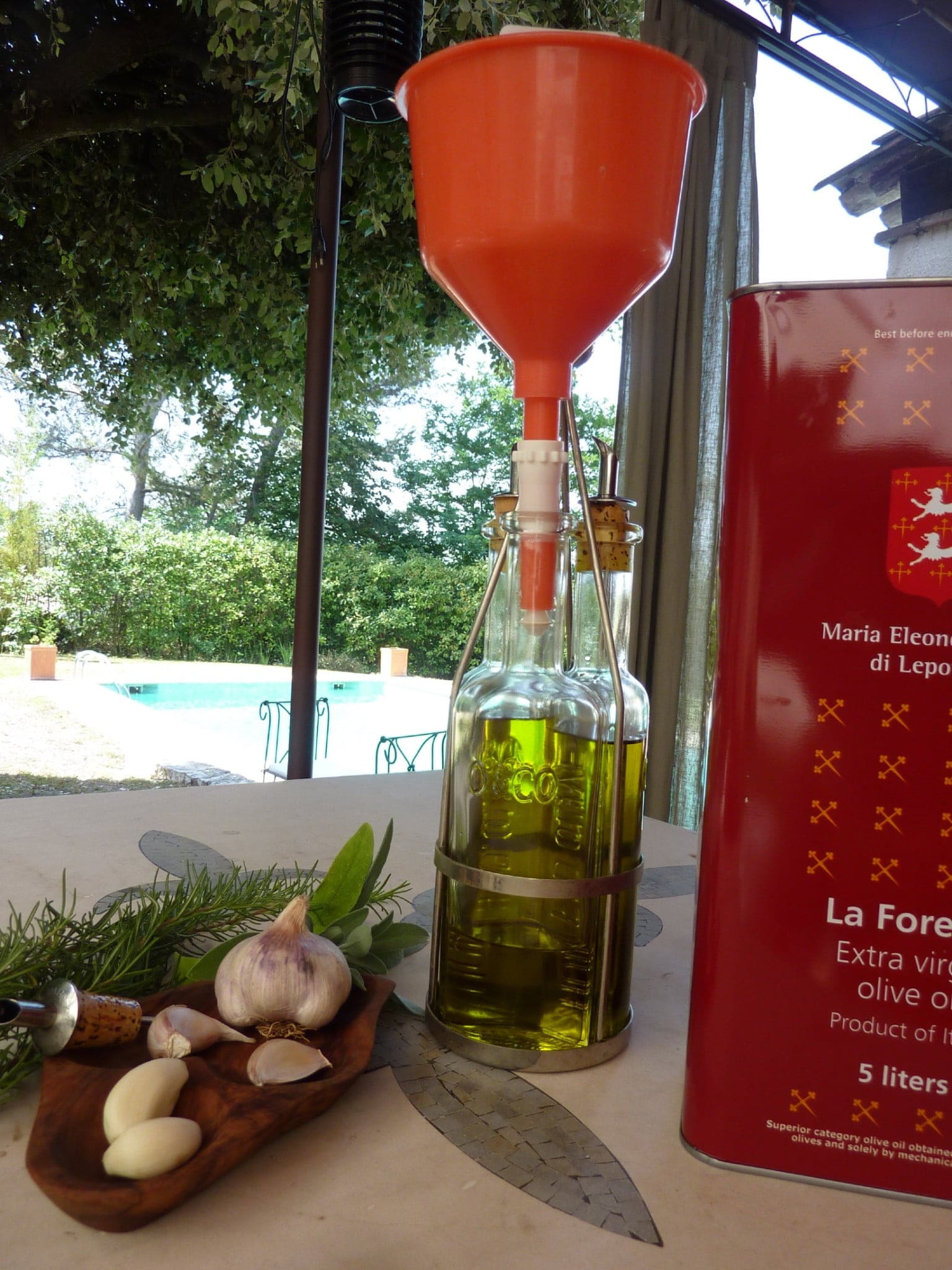
Optional extras
Incorporating raisins, nuts, and other whole grains into a salad not only introduces diverse textures, from the chewiness of raisins to the crunch of nuts, but also elevates the flavor profile with sweet and nutty undertones.
These additions infuse depth and complexity, making each bite a multi-layered experience, rich in both taste and nutritional benefits.
- Raisins and Nuts: Sweet raisins contrast with crunchy nuts like pinenuts or toasted almonds.
- Whole Grains: Adding other grains can make the salad even heartier.
Given the multitude of salad ingredients and dressing ingredients you can use, Italian rice salad becomes a canvas for culinary creativity.
It's all about finding the perfect balance of textures and flavors!
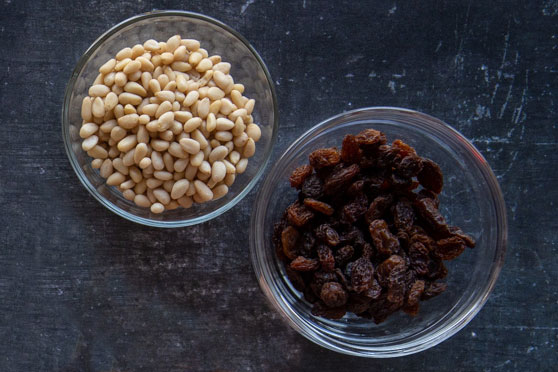
Instructions
Cooking the Rice the Italian way
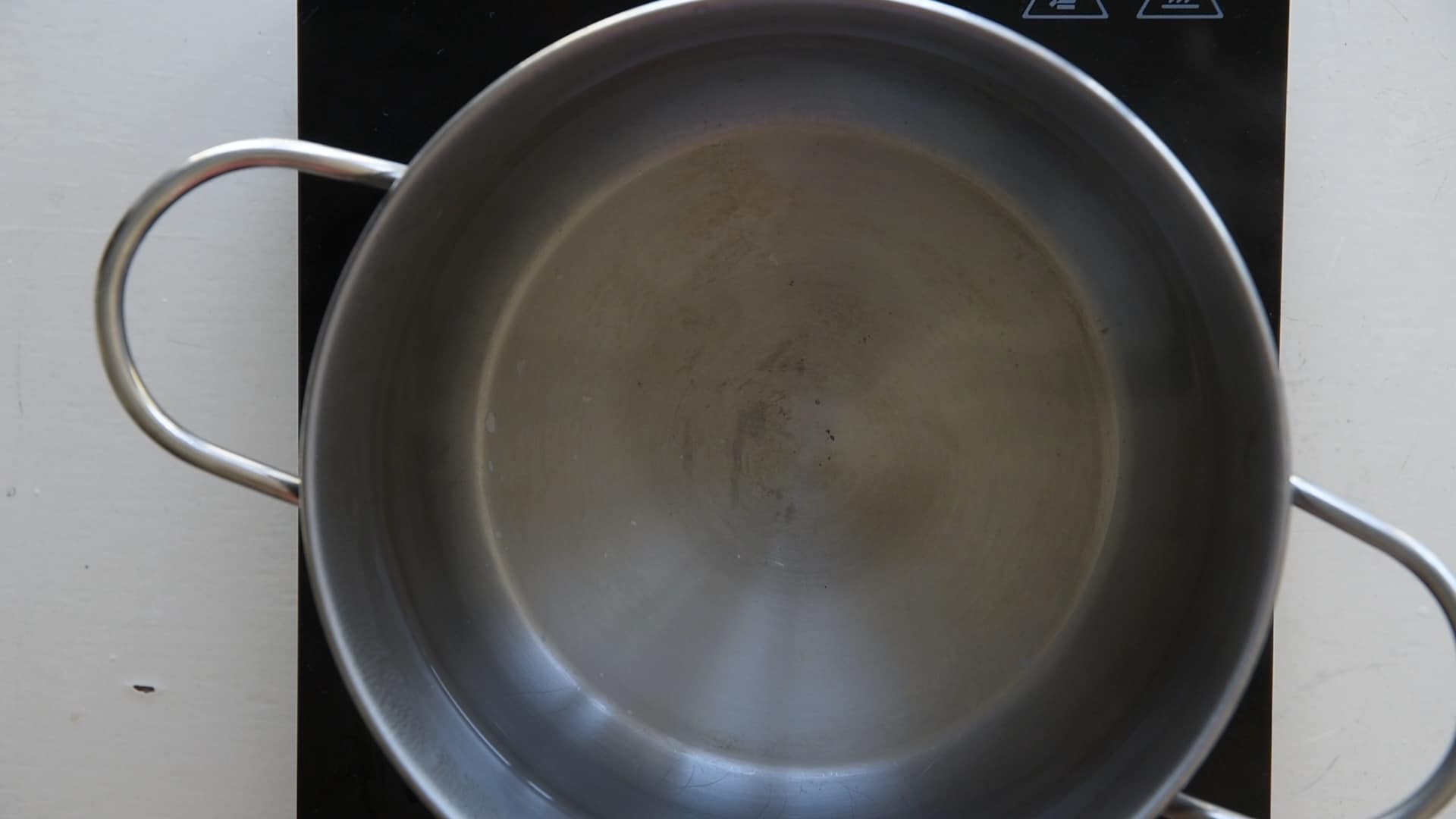
- Bring a large pot of water to a rolling boil, similar to how you would for pasta.
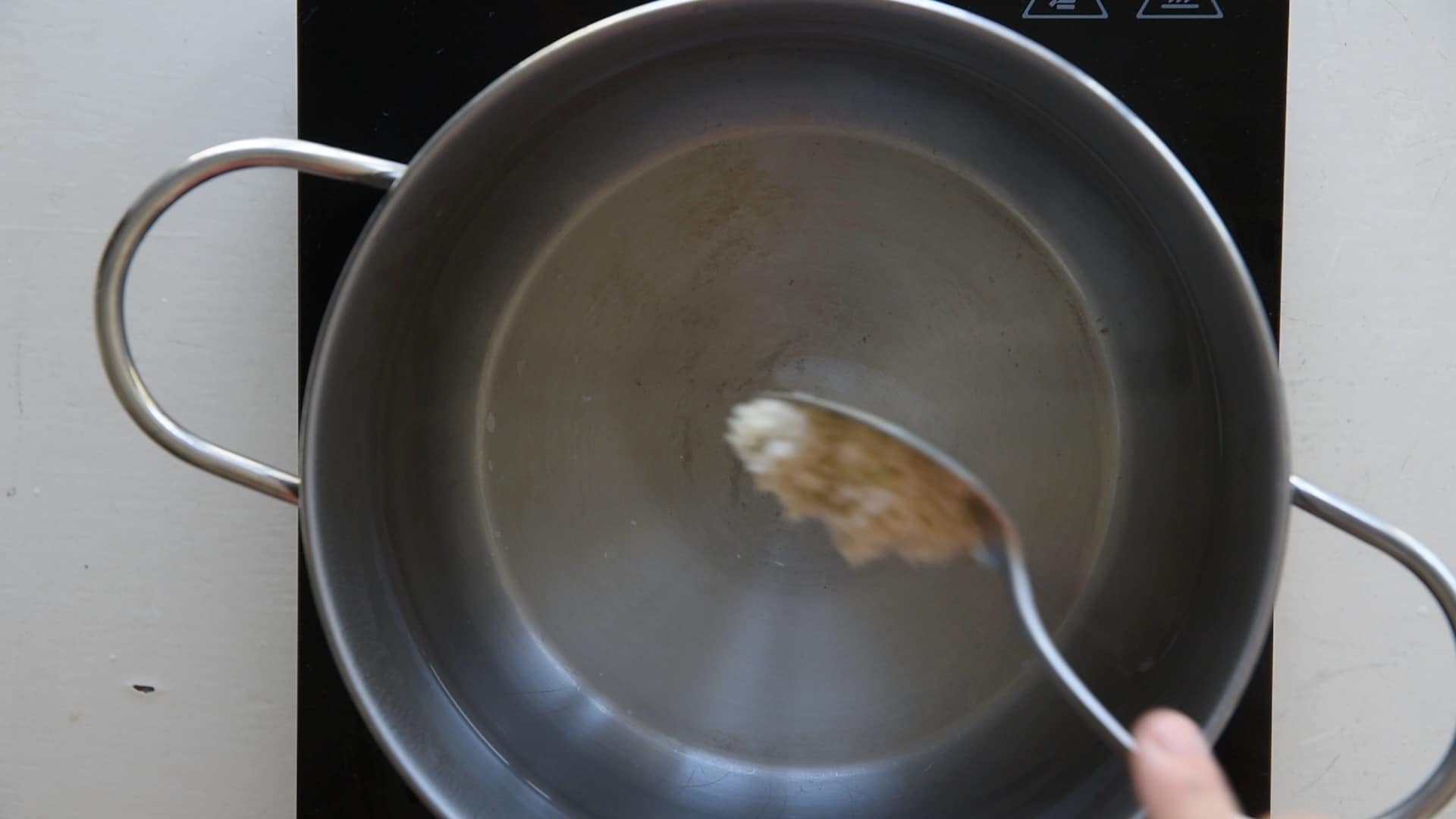
- Salt the water generously.
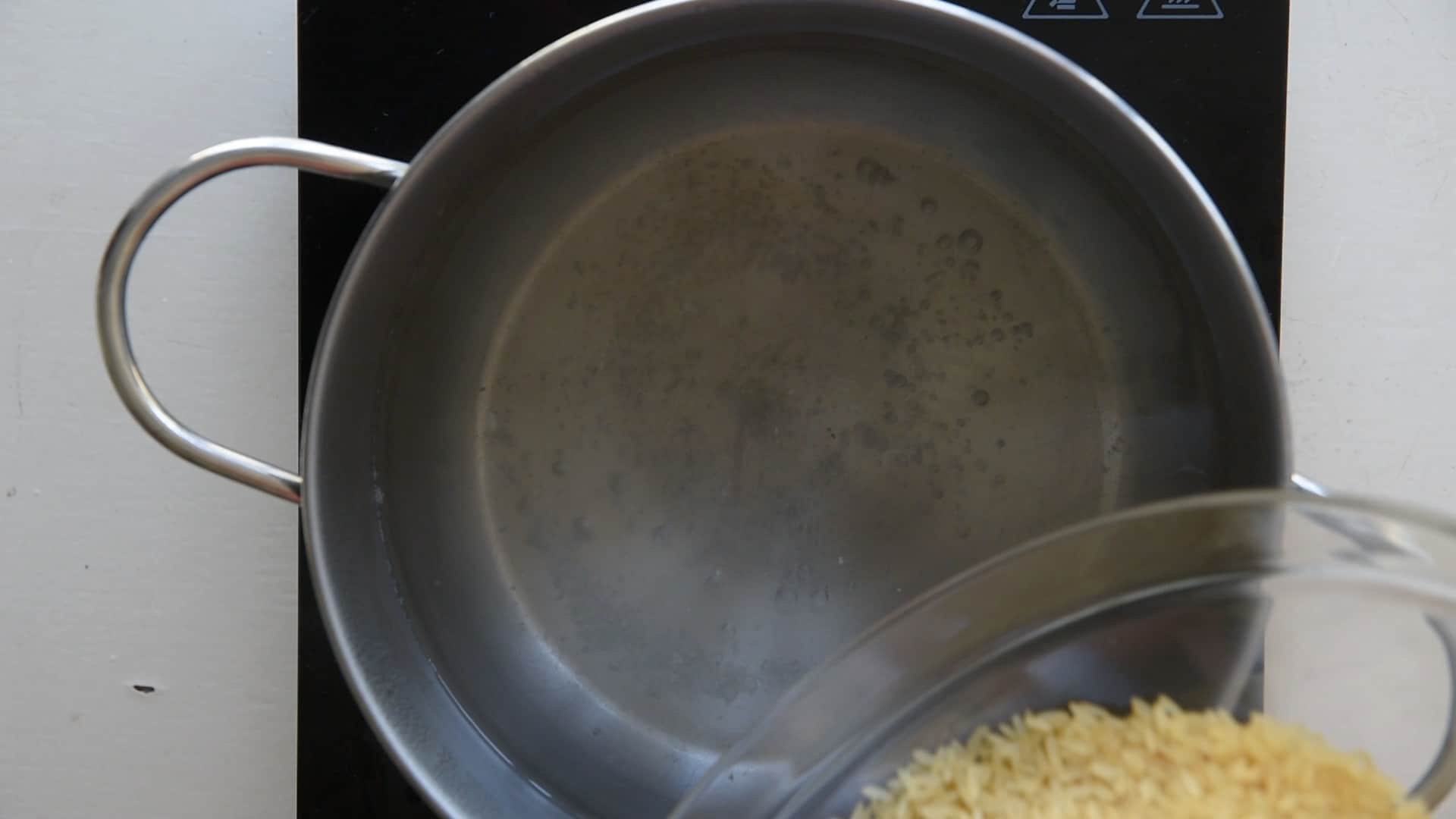
- Once boiling, add the rice to the pot.
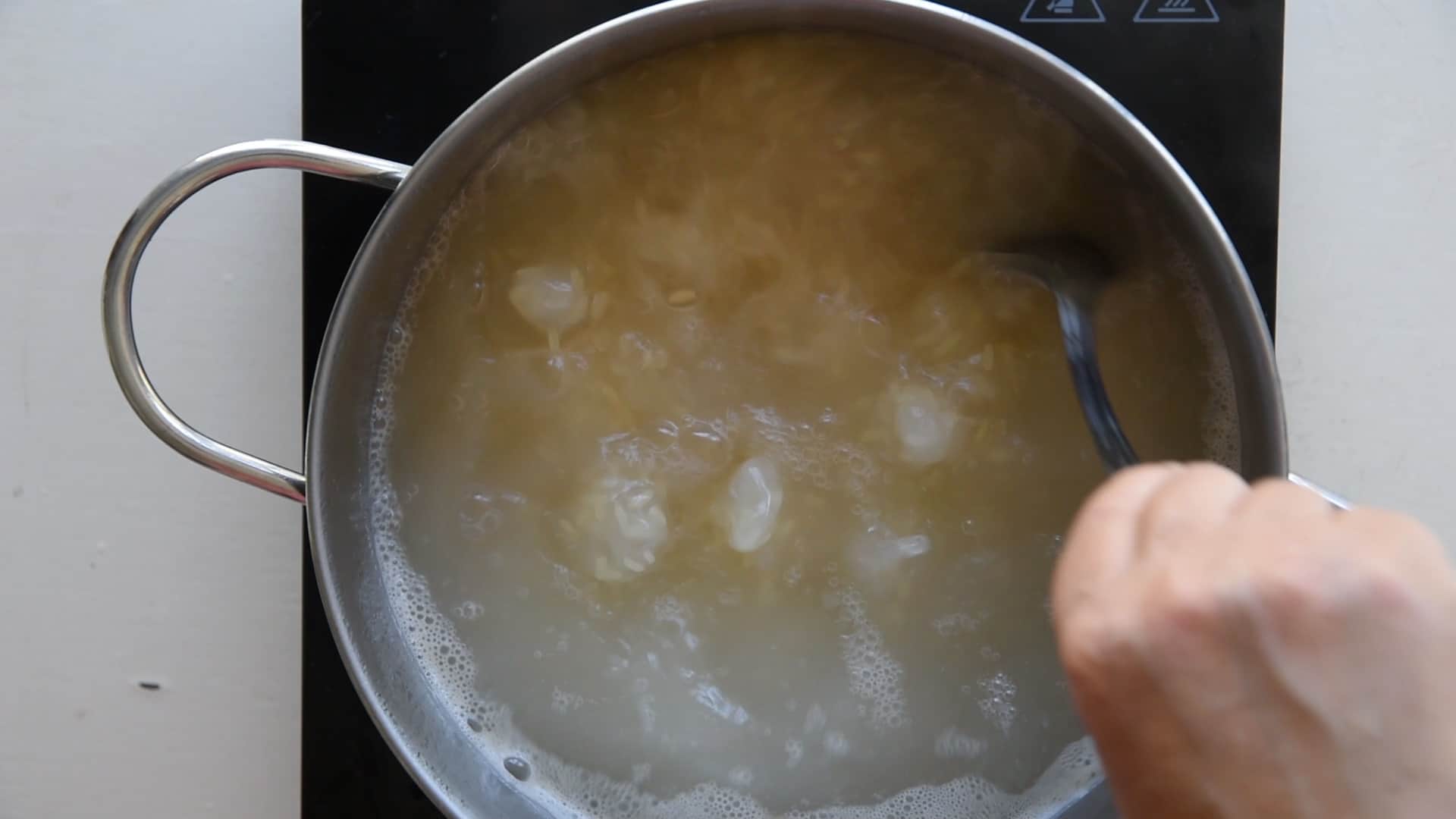
- Let the rice boil uncovered, stirring occasionally to prevent sticking
- The cooking duration will depend on the rice you use. Read the box for directions and cook 1 minute less
- Carnaroli/Arborio: 18-20 minutes
- Vialone Nano: 15-18 minutes
- Basmati: 10-12 minutes
- Taste a few grains to ensure it's cooked to your preferred level of doneness. For rice salads, it's preferable to have the rice al dente.
- Once cooked, drain the rice in a colander, getting rid of all the excess water.
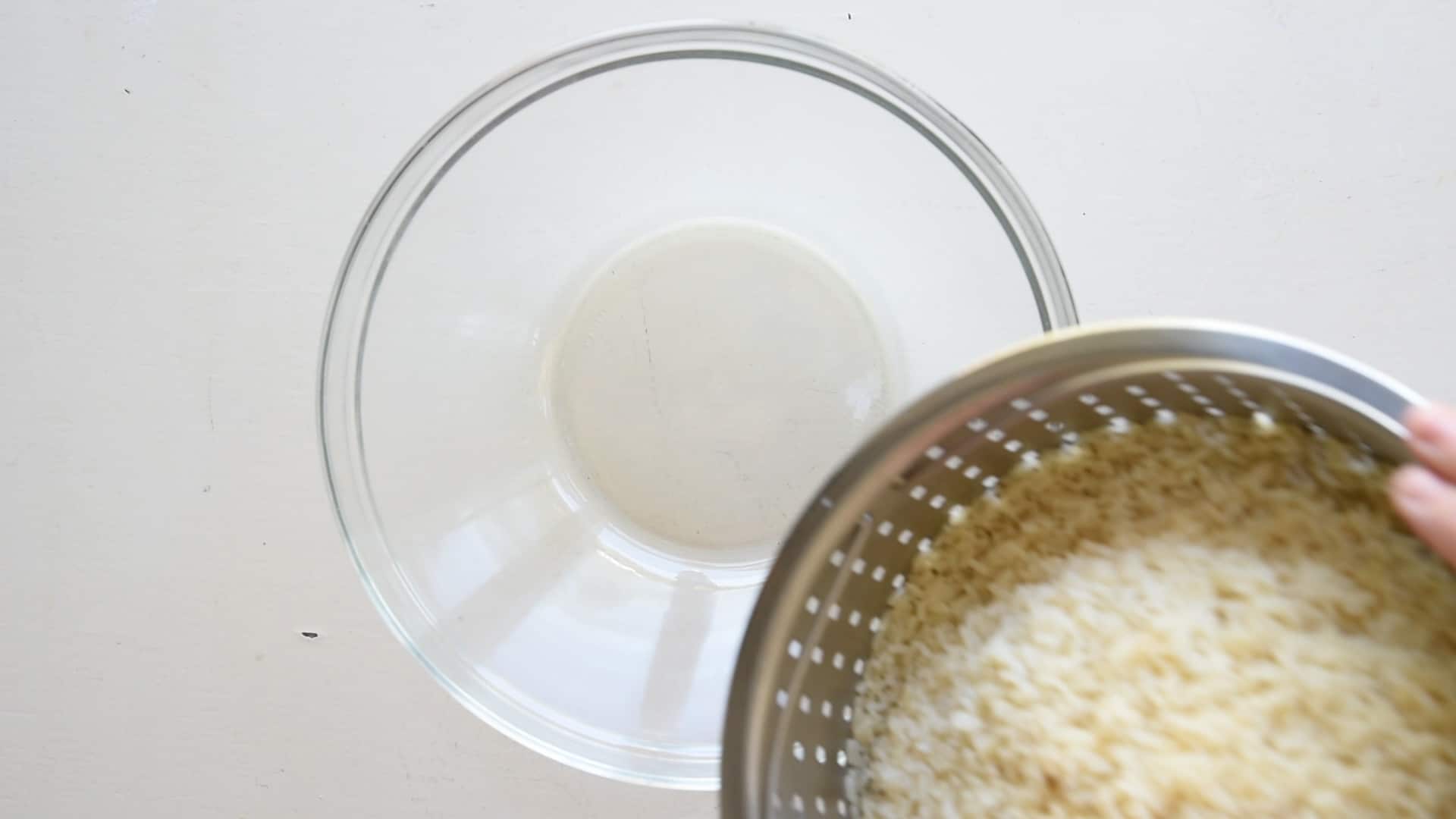
Cooling the Rice
- Immediately spread the drained rice onto a large flat plate or tray in an even layer. This helps to stop the cooking process and cools the rice quickly, preventing it from becoming too soft or sticky.
- Allow the rice to cool to room temperature. If in a hurry, you can also place the plate in a cooler spot or even in the refrigerator for a short while to expedite the cooling process.
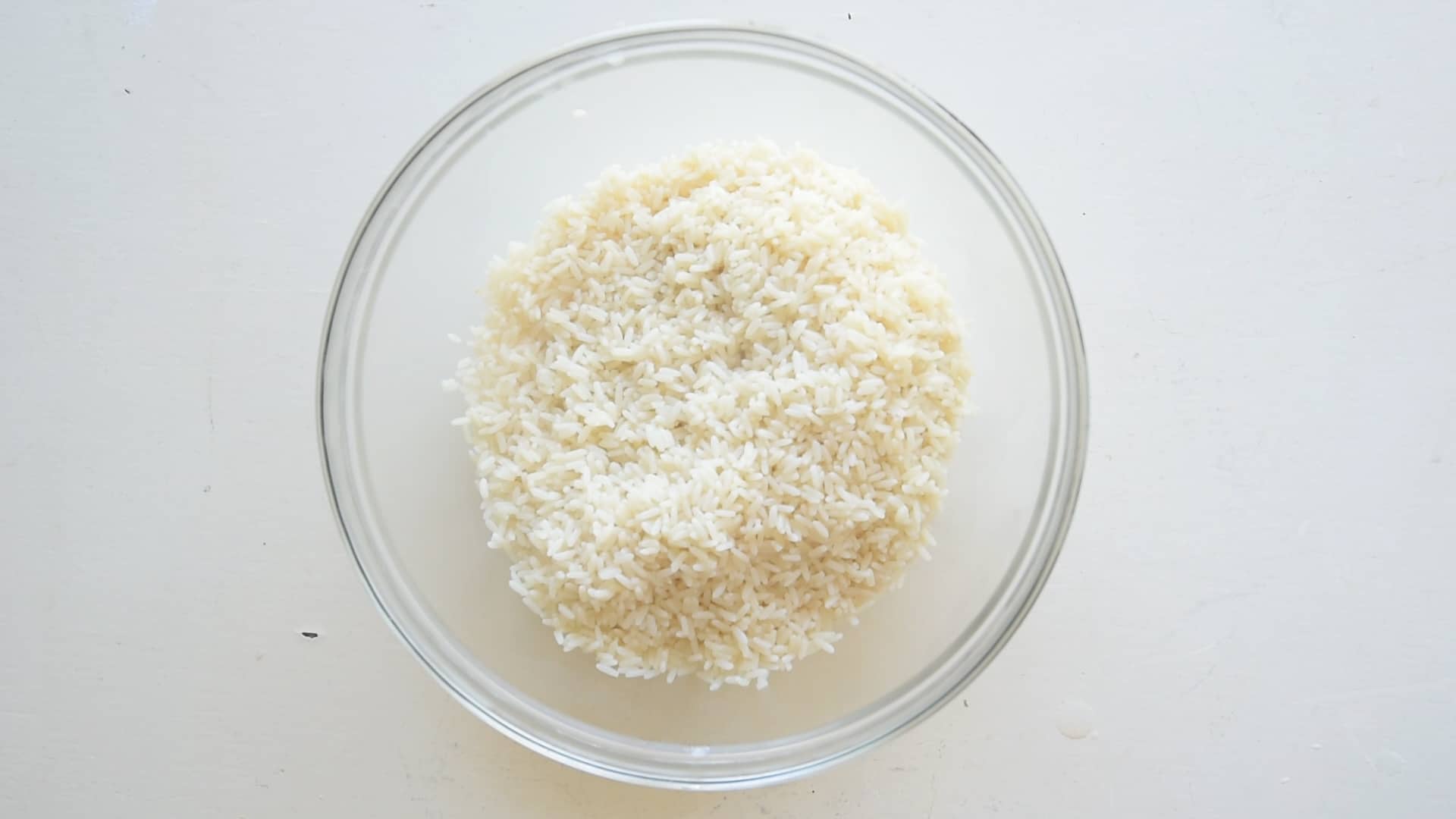
Prepping the Vegetables
- Wash all vegetables under cold running water.
- Use a sharp knife to dice or chop vegetables uniformly to ensure even cooking (if necessary) and a consistent bite.
- For added crunch, blanching certain vegetables like broccoli or beans briefly in boiling water and then immediately cooling them in an ice bath can retain their vibrant color and crispness.
Hint: to make this recipe even easier, I used canned vegetables. They are a good alternative if you in a rush
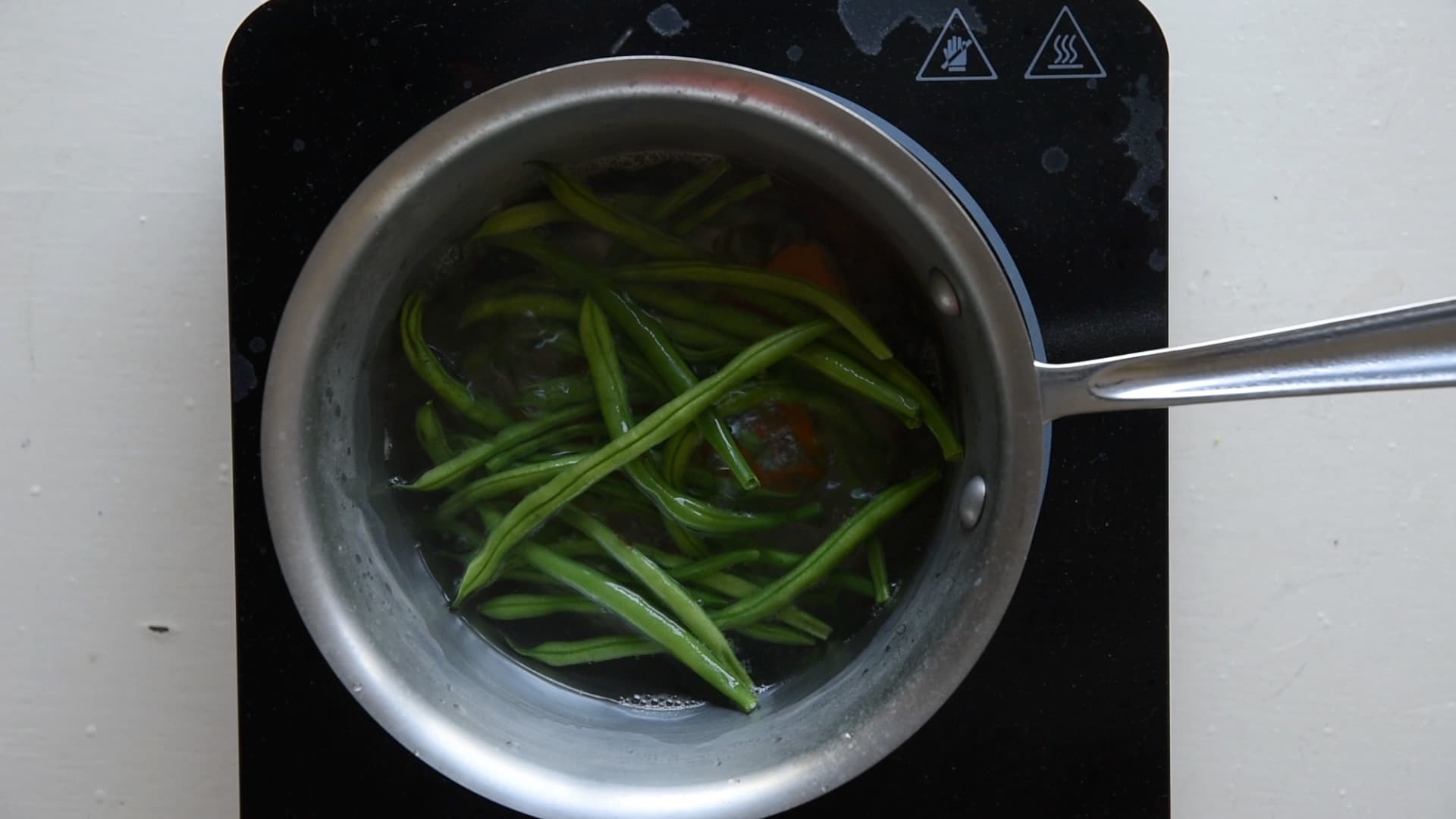
Making the Dressing
- Start with a basic ratio of 3 parts oil to 1 part acid (like vinegar or lemon juice).
- Whisk together until emulsified. Add salt and pepper to taste.
- Experiment with variations: add minced garlic, mustard, honey, or herbs to suit different taste preferences.
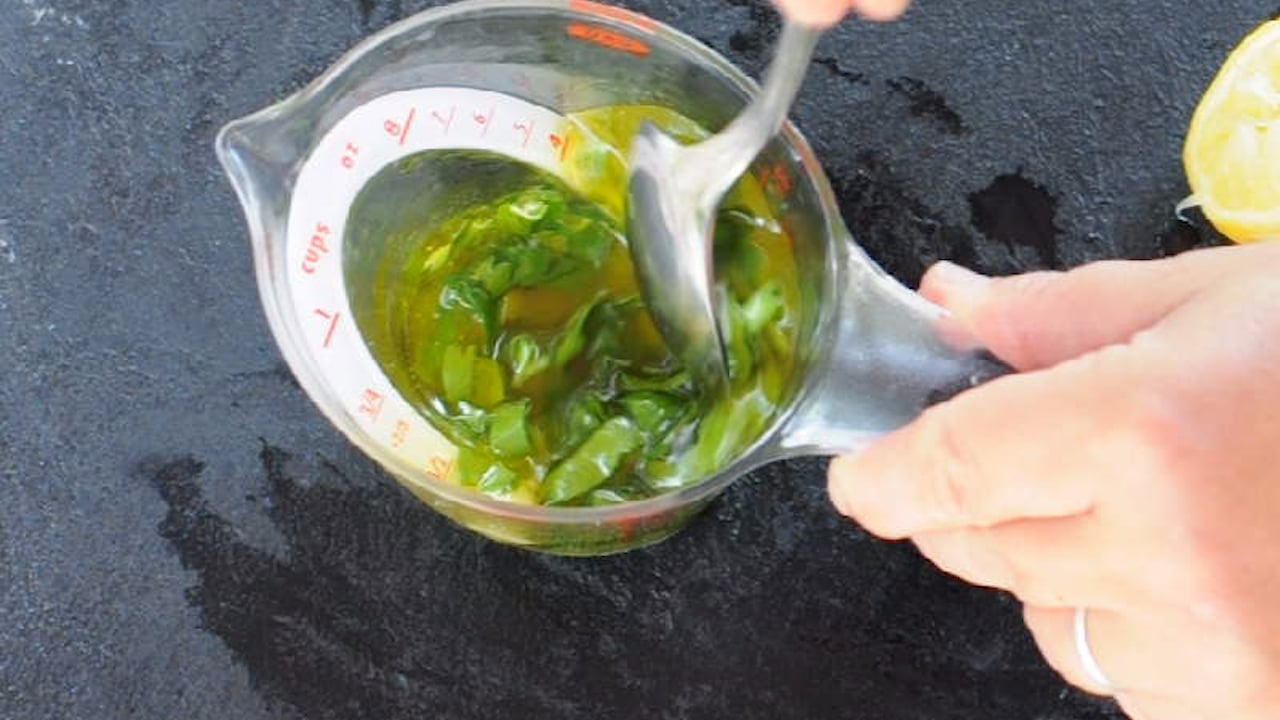
Combining Ingredients
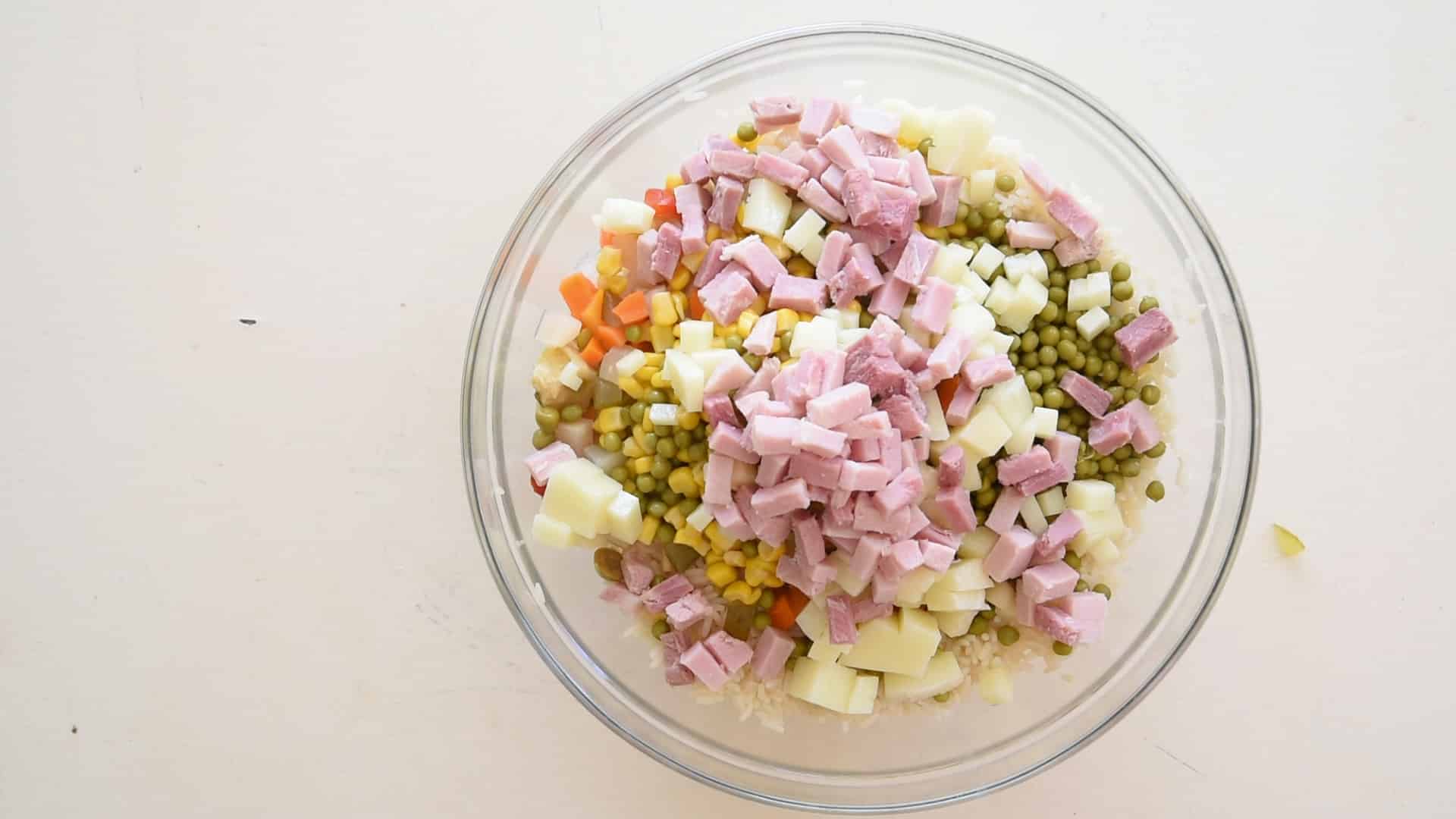
- In a large bowl, combine cooled rice, prepped vegetables, and any additional ingredients like raisins or nuts.
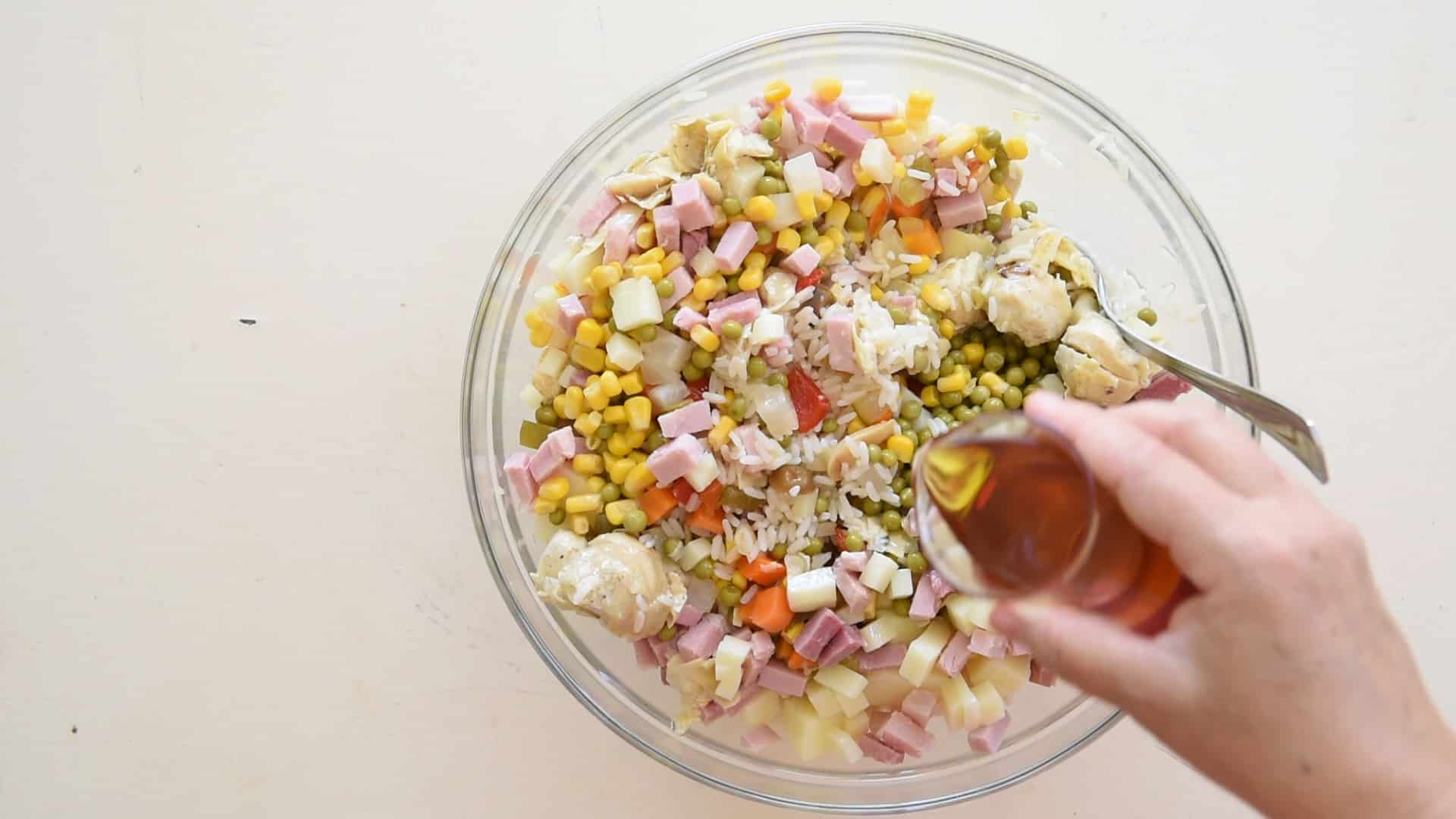
- Pour the dressing over the mixture
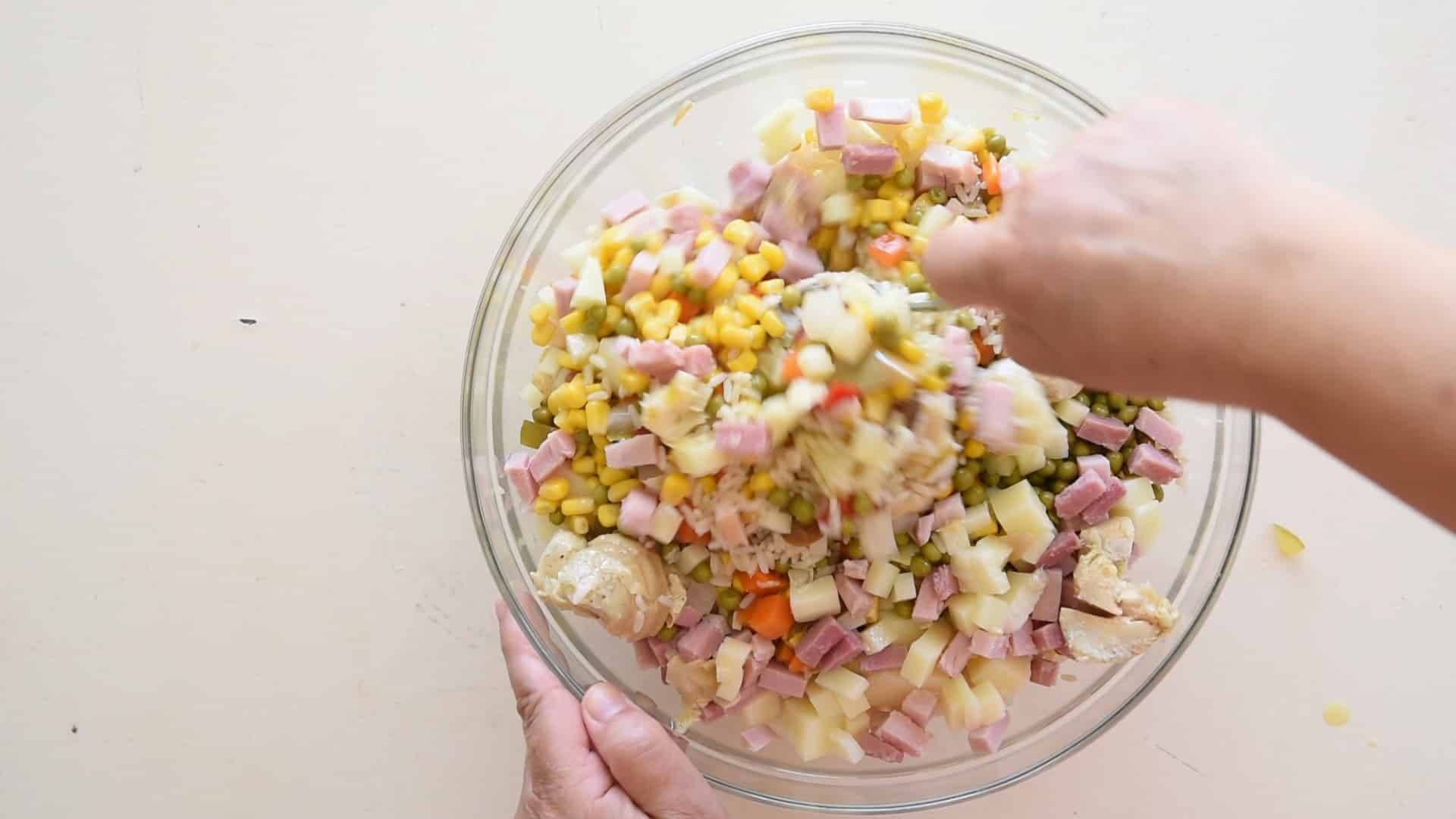
- Gently fold everything together to ensure an even distribution of ingredients and flavors.
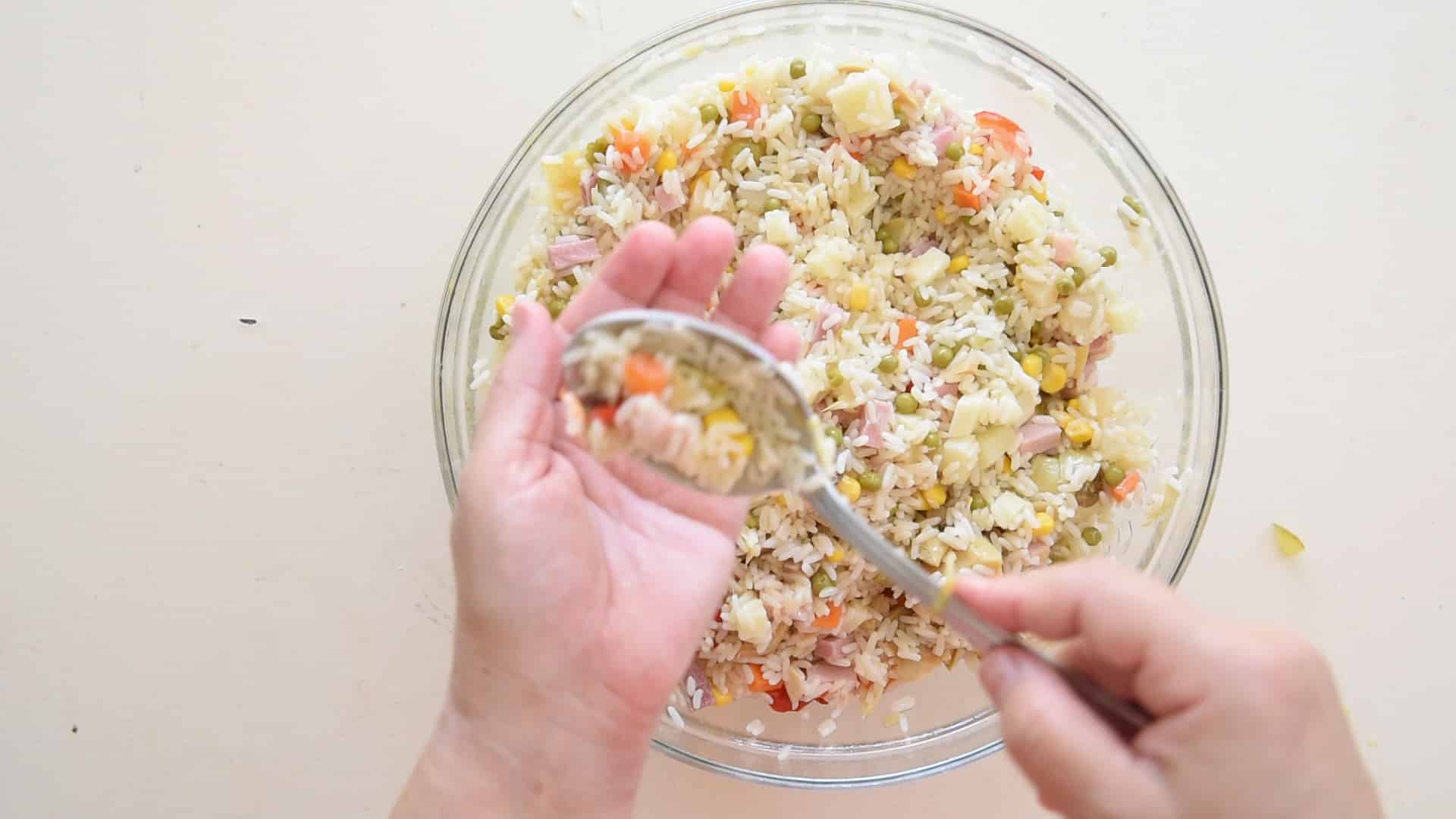
- Taste and adjust seasoning as necessary, adding more salt, pepper, or dressing if needed.
Serving suggestions
Serving a rice salad with finesse amplifies the eating experience and accentuates the love and effort invested in its preparation.
Here are some suggestions to ensure your rice salad makes a lasting impression:
Presentation Tips:
- Plating: Use a shallow, wide serving dish to display the colorful ingredients prominently. This will allow the variety within the salad to shine.
- Garnish: Elevate the look by garnishing with freshly chopped herbs, a sprinkle of seeds, or a drizzle of extra virgin olive oil.
- Layering: Consider layering ingredients for a tiered effect, especially if your salad has components that might sink to the bottom.
- Serving Tools: Opt for large, wide serving spoons or forks to ensure easy serving without crushing the ingredients.
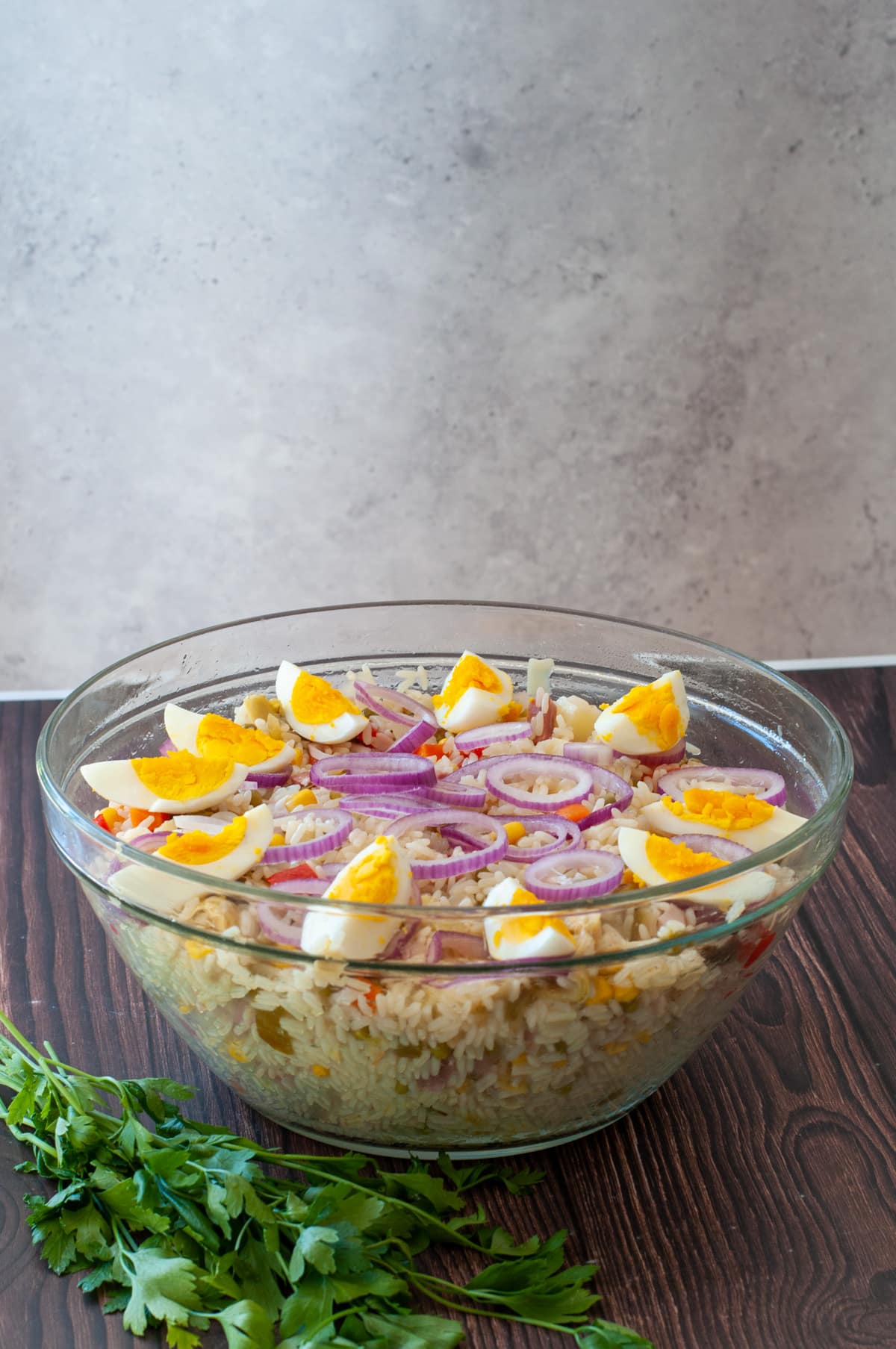
Suitable Side Dishes or Beverages:
- Breads: A side of crusty Italian bread or grissini (breadsticks) pairs beautifully with rice salad, offering a contrasting texture.
- Wine: A crisp white wine, such as Pinot Grigio or Vermentino, complements the fresh flavors of a rice salad.
- Non-Alcoholic: Sparkling water with a splash of lemon or lime or an iced herbal tea can be refreshing complements.
Portion recommendations for different occasions:
- Lunch/Dinner Main: If the rice salad is the star of the meal, allocate about 1 to 1.5 cups per person.
- Picnics/Barbecues: As part of a larger spread, reduce the portion to about ¾ to 1 cup per person.
- Appetizer or Side: If you're serving the rice salad as a precursor to the main meal or as a side dish, ½ to ¾ cup per person should suffice.
- Large Gatherings: For big events where many dishes are available, assume smaller portions, as not everyone might partake or they'll take smaller amounts to leave room for other foods.
With these serving suggestions, your rice salad will not only tantalize the taste buds but also be a feast for the eyes, ensuring your dish is memorable for all the right reasons.
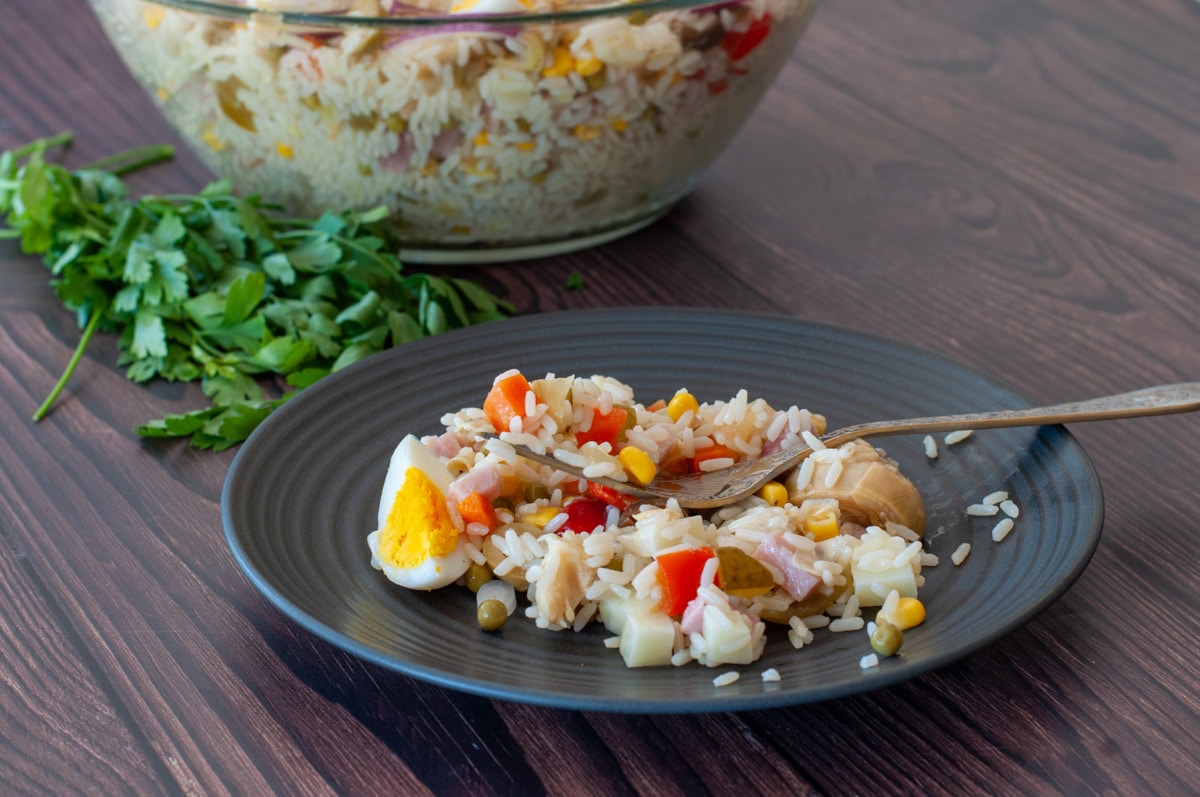
Variations and Tips
Here are some suggested ingredient swaps based on dietary restrictions:
- Gluten-Free: Opt for tamari or a gluten-free soy sauce if your dressing recipe requires soy sauce. Ensure any added sauces or broths are gluten-free.
- Vegan: Replace animal-based proteins with plant-based options like tofu, tempeh, or chickpeas. If your dressing uses honey, swap it for maple syrup or agave nectar.
Storage and leftovers
Always store your rice salad in an airtight container to prevent it from drying out.
For optimal freshness, consume leftovers within 2-3 days.
If the salad contains ingredients that can wilt or become soggy (like certain veggies or herbs), consider storing them separately and mixing them in just before eating.
Quick Version
Here are some recommendations if you are short on time:
- Use pre-cooked or instant rice to save on cooking time. Just ensure it's cooled before using.
- Opt for pre-cut, canned, pickled or frozen vegetables. They can be a real time-saver, and many retain their nutritional value quite well.
- Store-bought dressings can be a quick alternative. Just ensure they align with the flavor profile you're aiming for and adjust for personal taste.
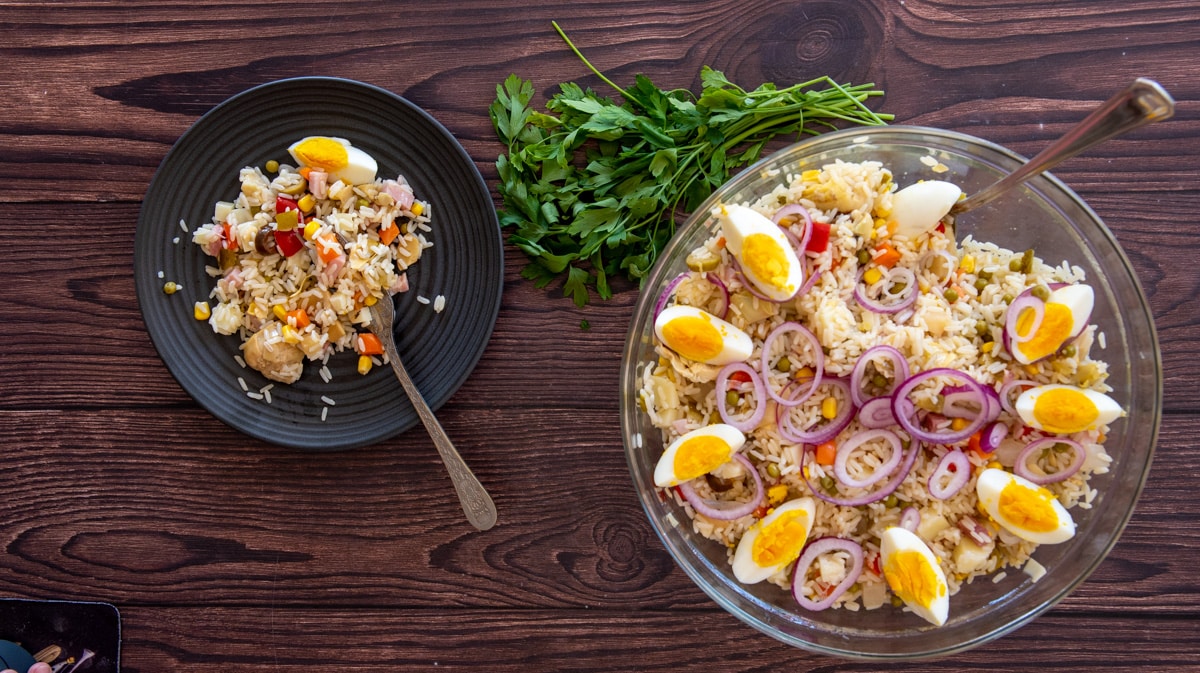
Meal ideas
Rice salad is a versatile dish that can grace various tables regardless of the occasion or season:
- Summer Picnics: Given its refreshing and cool nature, rice salad is a favorite for summer outings, picnics, or beach trips.
- Family Gatherings: Its ability to be prepared in large quantities easily makes rice salad an excellent choice for large family gatherings or reunions.
- Potluck Events: As a dish that pairs well with many other foods, rice salad is a potluck favorite.
- Spring Brunches: As the weather begins to warm, a light and flavorful rice salad can be an appealing dish for mid-day meals.
- Health Retreats: For those focusing on healthier eating options, rice salad can be a nutritious addition to retreat menus.
- Barbecue Sides: While meats take center stage at BBQs, a cold rice salad can offer a refreshing counterpoint to grilled foods.
- Holiday Celebrations: With appropriate festive tweaks, rice salad can be a unique dish for holidays like Easter or Fourth of July.
- Busy Weeknight Dinners: Given its ease of preparation, rice salad can be a quick yet fulfilling meal option for those busy evenings.
- Lunchboxes: A hearty rice salad can be an excellent lunch option, providing energy for the day ahead.
- Winter Buffets: Even in colder months, rice salad, when paired with ingredients like roasted veggies or warm spices, can be a delightful addition to a winter spread.
Remember, the beauty of rice salad lies in its adaptability, allowing it to fit seamlessly into various occasions and seasons.
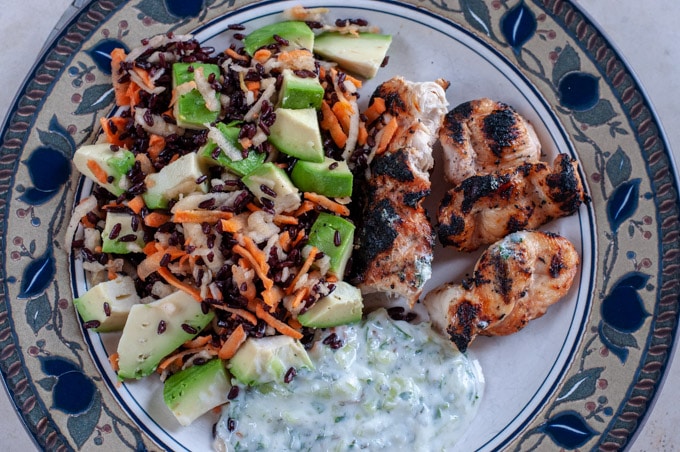
Other cold recipes
Other cold recipes you can serve with this rice salad
If you are making any of these Italian breakfasts, leave your comment below I would like to hear from you. You can find more delicious ideas if you FOLLOW ME on Facebook, YouTube, or sign up to my newsletter.
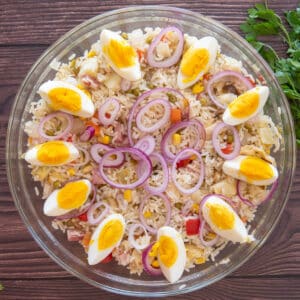
📋Rice Salad Recipe Insalata Di Riso
Ingredients
- 1 lb Carnaroli rice
- 2 cup Mixed boiled vegetables
- ½ cup Corn canned
- ½ cup Green peas canned
- ½ cup Jarred artichokes
- ¼ cup pitted black olives
- ½ cup cooked ham
- ½ cup cheese
- 4 tablespoon extra virgin olive oil
- 2 tablespoon white wine vinegar
- salt & pepper
Equipment
Instructions
Preparing the rice
- Bring a large pot of water to a rolling boil, similar to how you would for pasta.
- Salt the water generously.
- Once boiling, add the rice to the pot.1 lb Carnaroli rice
- Let the rice boil uncovered, stirring occasionally to prevent sticking
- The cooking duration will depend on the rice you use. Read the box for directions and cook 1 minute less
- Taste a few grains to ensure it's cooked to your preferred level of doneness. For rice salads, it's preferable to have the rice al dente.
- Once cooked, drain the rice in a colander, getting rid of all the excess water.
Cooling the Rice
- Immediately spread the drained rice onto a large flat plate or tray in an even layer. This helps to stop the cooking process and cools the rice quickly, preventing it from becoming too soft or sticky.
- Allow the rice to cool to room temperature. If in a hurry, you can also place the plate in a cooler spot or even in the refrigerator for a short while to expedite the cooling process.
Prepping the Vegetables
- Wash all vegetables under cold running water.
- Use a sharp knife to dice or chop vegetables uniformly to ensure even cooking (if necessary) and a consistent bite.
- For added crunch, blanching certain vegetables like broccoli or beans briefly in boiling water and then immediately cooling them in an ice bath can retain their vibrant color and crispness.
Making the Dressing
- Start with a basic ratio of 3 parts oil to 1 part acid (like vinegar or lemon juice).4 tablespoon extra virgin olive oil, 2 tablespoon white wine vinegar
- Whisk together until emulsified. Add salt and pepper to taste.salt & pepper
- Experiment with variations: add minced garlic, mustard, honey, or herbs to suit different taste preferences.
Combining Ingredients
- In a large bowl, combine cooled rice, prepped vegetables, and any additional ingredients like raisins or nuts.2 cup Mixed boiled vegetables, ½ cup Corn, ½ cup Green peas, ½ cup Jarred artichokes, ¼ cup pitted black olives, ½ cup cooked ham, ½ cup cheese
- Pour the dressing over the mixture
- Gently fold everything together to ensure an even distribution of ingredients and flavors.
- Taste and adjust seasoning as necessary, adding more salt, pepper, or dressing if needed.
- Decorate the plate and serve
Video
Notes
-
- Carnaroli/Arborio: 18-20 minutes
-
- Vialone Nano: 15-18 minutes
-
- Basmati: 10-12 minutes
-
- Plating: Use a shallow, wide serving dish to display the colorful ingredients prominently. This will allow the variety within the salad to shine.
-
- Garnish: Elevate the look by garnishing with freshly chopped herbs, a sprinkle of seeds, or a drizzle of extra virgin olive oil.
-
- Layering: Consider layering ingredients for a tiered effect, especially if your salad has components that might sink to the bottom.
-
- Serving Tools: Opt for large, wide serving spoons or forks to ensure easy serving without crushing the ingredients.
- Lunch/Dinner Main: If the rice salad is the star of the meal, allocate about 1 to 1.5 cups per person.
- Picnics/Barbecues: As part of a larger spread, reduce the portion to about ¾ to 1 cup per person.
- Appetizer or Side: If you're serving the rice salad as a precursor to the main meal or as a side dish, ½ to ¾ cup per person should suffice.
- Large Gatherings: For big events where many dishes are available, assume smaller portions, as not everyone might partake or they'll take smaller amounts to leave room for other foods.
Storage and leftovers
Always store your rice salad in an airtight container to prevent it from drying out. For optimal freshness, consume leftovers within 2-3 days. If the salad contains ingredients that can wilt or become soggy (like certain veggies or herbs), consider storing them separately and mixing them in just before eating.Nutrition





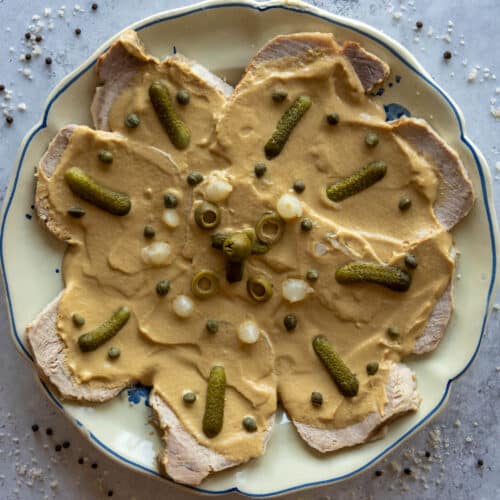
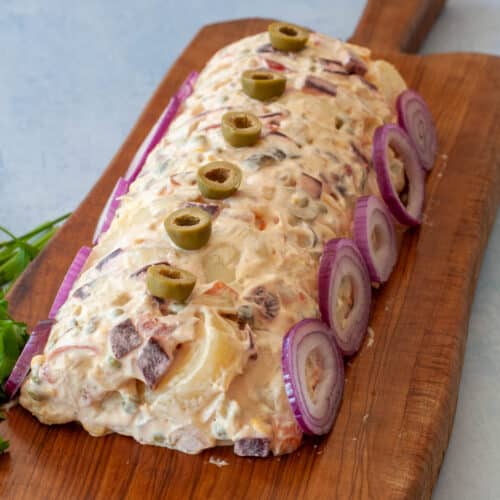
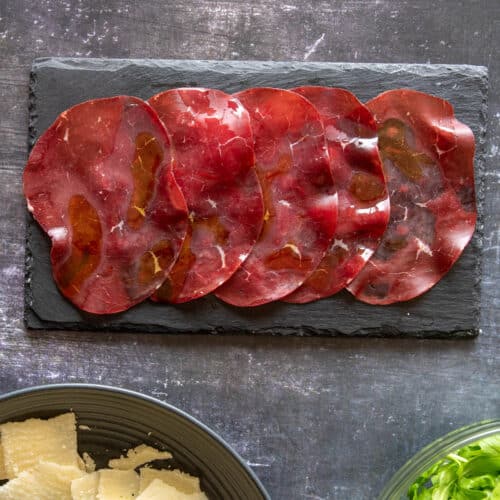
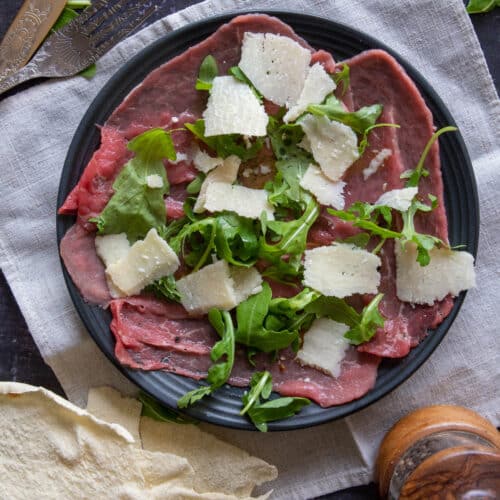

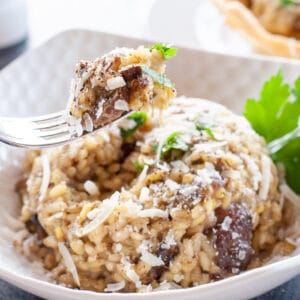
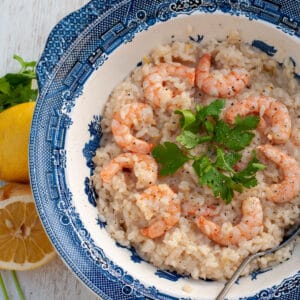

Leave a Reply